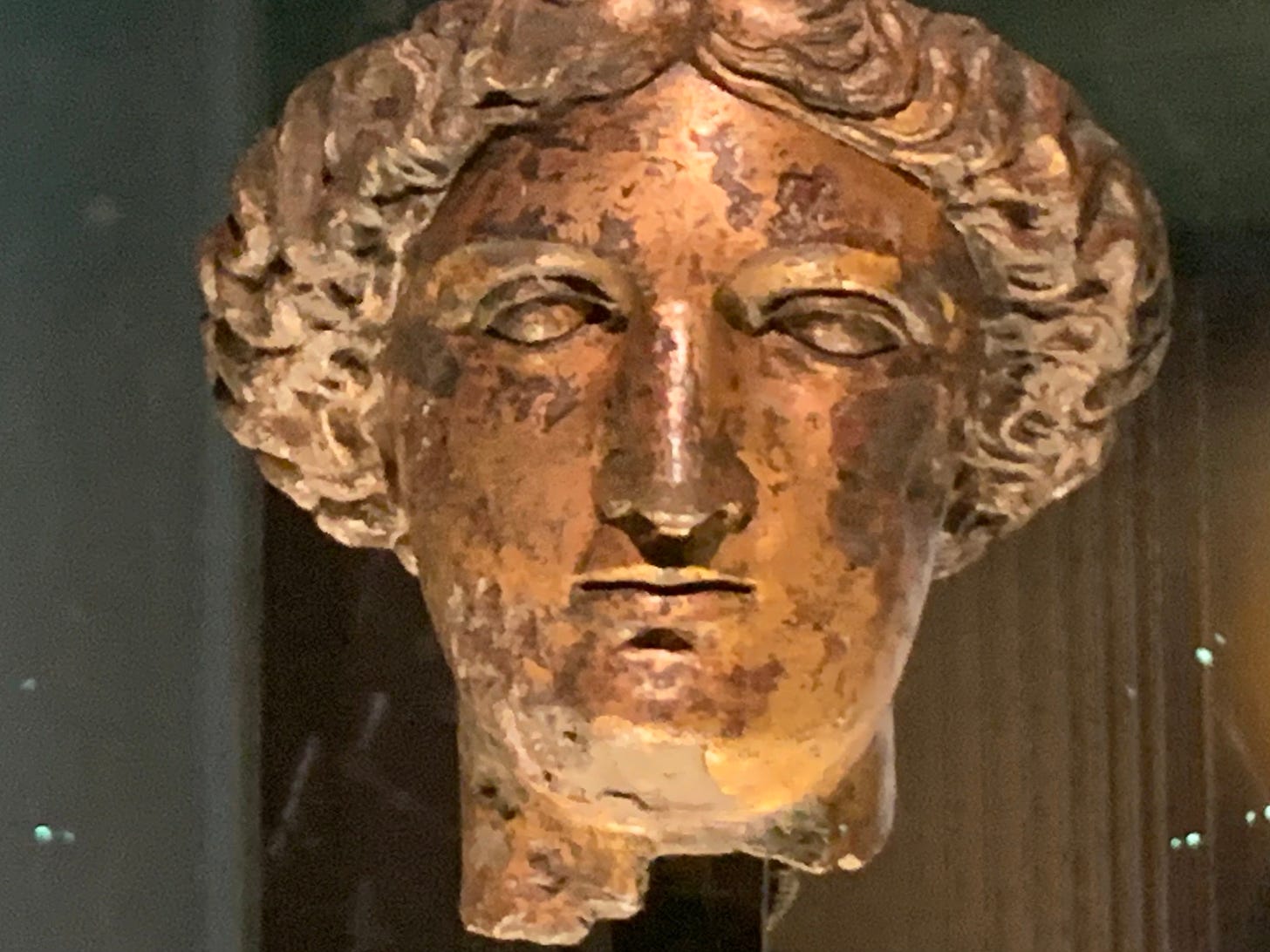On the base of my writing desk lamp perches a small owl, unfortunately not alive, that my daughter recently gave me as a souvenir of our time together in Bath, England. While there, we went to a spa and soaked in waters fed by the same spring as the ancient Roman baths. We could feel the difference in buoyancy, in our own gravity, as the minerals circulated around us. The original Roman baths include a temple to Sulis Minerva, goddess of wisdom and warfare.
In the Roman baths themselves, Minerva’s head now floats detached from the rest of her destroyed statue’s body, encased in glass and glimmering with gold leaf. Frankly, she looks as imposing af, which is as it should be. One of Minerva’s symbols is the owl, which her predecessor Athena also had. I’m not sure how the owl came to be associated with wisdom originally, though I do know that it is in many cultures associated with death as well; I imagine there is probably a connection there. Mortality, if we dare to remember it, wakes us up. It yanks us into a bird’s eye view of our lives and forces us to reckon with how we create meaning within them. It provides us with perspective.
That perspective, in turn, involves memory. The word “souvenir” comes from the French verb, which means to remember. But what I find fascinating is that French verb is reflexive: je me souviens. I come back. I come back to myself, within myself. And in coming back to the self, we also come back to the not-self, that which is outside us but connected to us through experience. We recognize the difference, hopefully.
My favorite proverb from the Christian bible is: The beginning of wisdom is this: get wisdom (Prov 4:7). We must know we want it. We must know we don’t yet have it. We must look for it, deliberately.
One place we must look for it is in the past. That past is always a site of contention, but that doesn’t make the past any less real. In the eighteenth-century, collectors wanted complete ancient statues and cobbled them together from different eras. A statue of Athena, known as the “Halstead Athena,” with war helmet, aegis, and a small owl in hand, is now on display at the Wrightwood 659 gallery in Chicago. Its head was carved during the reign of Augustus (31 BCE to 14 CE) whereas its body was sculpted during the reign of Claudius (41 CE to 54 CE). Although eighteenth-century collectors like William Wendell knew their statues were made up of pieces rather than found intact, they wanted the impression of something whole, complete, and ancient.[1] They were not interested in the nuances of fragments.
It’s not that fragments can’t be pieced together. Of course they can. But it is important to acknowledge that they are fragments and therefore remind us not just of what has survived, but also of what hasn’t. We are re-membering. The fragments are not the whole story. Wisdom involves recognizing that.
In the U.S. these days, there is a concerted effort to redact history, to pretend like past slavery doesn’t have its claws in current structural racism, to pretend like gender is determined by sex and is binary, to pretend like every society has naturally been organized around men.[2] This pretending, this denial, is not remembering, is not wisdom.
Wisdom knows wisdom doesn’t always win, but wisdom always seeks itself.
The small bronze-colored owl fits nicely into one’s palm, but wisdom is harder to grasp. The owl’s large eyes and cocked head remind us to be curious, to be open, not to think we already know what we do not know.
[1] Eli Wizevich, “See the Stunning Ancient Roman Statue of Athena That’s Going on View for the First Time in Nearly 260 Years,” Smithsonian Magazine, 23 Jan. 2025, https://www.smithsonianmag.com/smart-news/see-the-stunning-ancient-roman-statue-of-athena-thats-going-on-view-for-the-first-time-in-nearly-260-years-180985883/
[2] Get ready for a loooooong endnote. Current ICE raids to deport immigrants are targeting people and communities of color, specifically, and relying on racial profiling according to reports in Suzanne Gamboa and Nicole Acevedo’s “Trump Immigration Raids Snag U.S. Citizens, including Native Americans, Raising Racial Profiling Fears,” NBC News, 28 Jan. 2025, https://www.nbcnews.com/news/latino/trump-immigration-raids-citizens-profiling-accusations-native-american-rcna189203. Science has long known that there are more than two biological sexes in the natural world, as in clownfish, trioecius nematodes, and white-throated sparrows. See Katherine J. Wu’s “Alternatives to Heterosexual Pairings, Brought to You by Non-Human Animals,” Smithsonian Magazine, 28 Jun. 2018, https://www.smithsonianmag.com/science-nature/alternatives-heterosexual-pairings-brought-you-non-human-animals-180969481/#:~:text=From%20male%20clownfish%20that%20ascend%20to%20female%20status%2C,outside%20the%20restrictive%20constraints%20of%20a%20two-sex%20binary. This doesn’t even address the fact that gender and biological sex are not the same thing. Certain Iron Age Celtic communities were matrilocal, meaning husbands moved to be with their wives instead of the more common reverse Lara Cassidy, et al., “Continental Influx and Pervasive Matrilocality in Iron Age Britain,” Nature 637 (2025): 1136-1142. Cassidy clarifies in an interview with the New York Times that while this didn’t necessarily mean women held official positions of power, it did indicate women’s much wider and deeper influence than previously acknowledged. Becky Ferreira, “Celtic Women Held Sway in ‘Matrilocal’ Societies,” New York Times, 15 Jan. 2025, https://www.nytimes.com/2025/01/15/science/celtic-women-dna.html.
I





I am 87 years old, still learning how to be wise.
The less I speak, the more I learn. I think the secret is
listen, listen, listen.